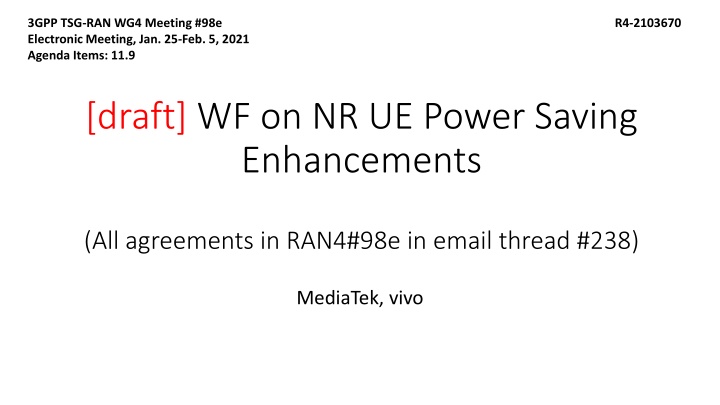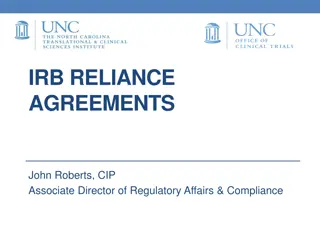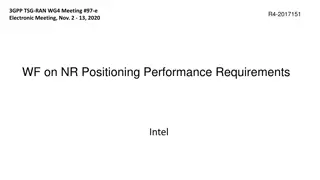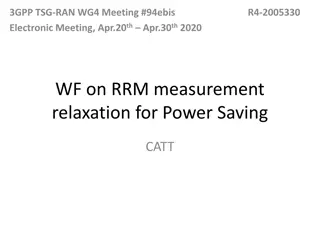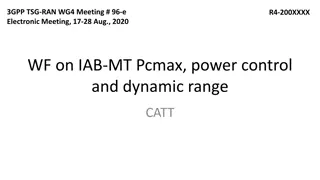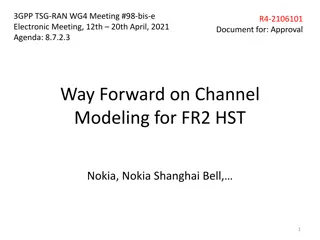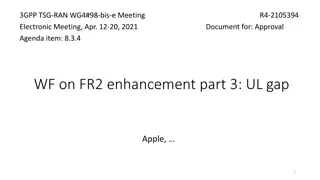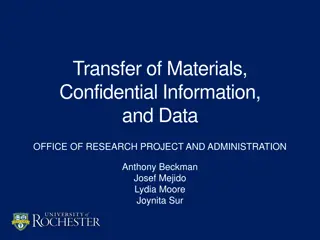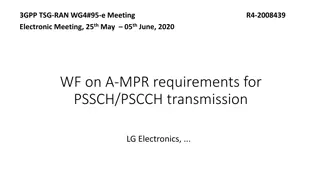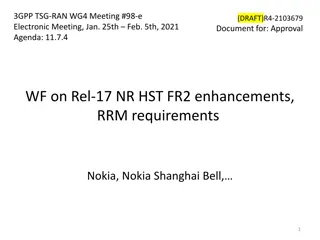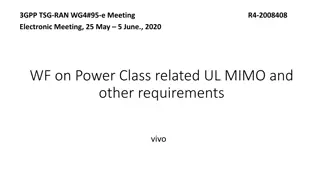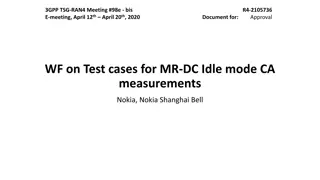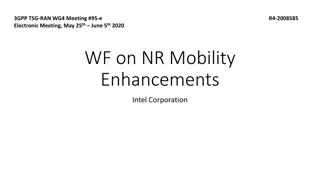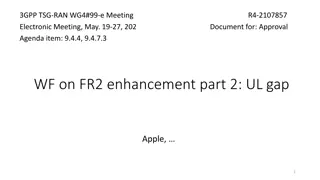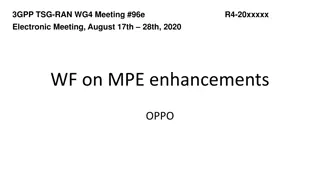NR UE Power Saving Enhancements - Agreements and Scenarios in 3GPP Meeting #98e
The agenda items for the 3GPP TSG-RAN WG4 Meeting #98e focus on enhancing power saving for NR UE. Discussions include agreements on RRM measurements, evaluation of power saving gains, identification of beneficial scenarios, and considerations for DRX cycles and relaxation criteria. The meeting aims to optimize power efficiency for UE implementations.
Download Presentation

Please find below an Image/Link to download the presentation.
The content on the website is provided AS IS for your information and personal use only. It may not be sold, licensed, or shared on other websites without obtaining consent from the author.If you encounter any issues during the download, it is possible that the publisher has removed the file from their server.
You are allowed to download the files provided on this website for personal or commercial use, subject to the condition that they are used lawfully. All files are the property of their respective owners.
The content on the website is provided AS IS for your information and personal use only. It may not be sold, licensed, or shared on other websites without obtaining consent from the author.
E N D
Presentation Transcript
3GPP TSG-RAN WG4 Meeting #98e R4-2103670 Electronic Meeting, Jan. 25-Feb. 5, 2021 Agenda Items: 11.9 [draft] WF on NR UE Power Saving Enhancements (All agreements in RAN4#98e in email thread #238) MediaTek, vivo
Agreements in GTW Issue 2-2-1: Confirmation on beneficial Scenarios, from UE power saving gain perspective Agreements Further evaluate UE power saving gains for the following UE implementations: UE meets Rel-15 RRM measurement period and accuracy requirements Option 1: UE uses all L1 samples for RRM measurements based on Rel-15 assumptions Option 2: How many L1 samples UE applies for RRM measurements is up to UE implementation (e.g. UE can use lower number of measurement samples for RRM measurements) Further discuss how many samples to use for evaluations Companies shall evaluate RRM measurements accuracy for the proposed number of samples. FFS whether Option 2 can be considered for requirements definition Further assess impact on PDCCH monitoring due to relax UE measurements for RLM/BFD
Scenarios for power saving Issue 2-2-1: Confirmation on beneficial Scenarios, from UE power saving gain perspective RAN4 to identify the scenarios that power saving gain can be observed. Issue 2-2-2: Feasible Scenarios for Power Saving, from system impact perspective RAN4 to identify the scenarios that system impact can be acceptable.
Scenarios for power saving Issue 2-2-3: DRX cycle The applicability of DRX cycles for RLM/BFD relaxation should be studied and decided based on the ongoing simulation study. FFS DRX cycle length <= 80 ms
Issue 2-3-1: Criteria which the UE is allowed to relax the RLM/BM requirements At least take UE mobility into account as the relaxation criteria. FFS whether and how to also take serving cell s quality into account FFS whether and how to take other aspects into account Issue 2-3-3: How to consider serving cell s quality as relaxation criteria RAN4 to further discuss how to take serving cell s quality into account for the relaxation criteria FFS how to consider serving cell s quality. E.g. Based on SINR or BLER. FFS how to address different UE implantation issues. FFS: When radio link quality > Qout + X (dB) for RLM and Qout,LR + Y (dB) for BFD relaxation X and Y are FFS.
Issue 2-3-2: How to consider UE mobility as relaxation criteria FFS the following options Option 1: R16 low-mobility criterion should not be directly reused in R17 SINR-based criterion for RLM/BFD relaxation. Option 2: R16 RRM relaxation criterion can be used as baseline for RLM/BFD relaxation. Option 3: low mobility criteria should consider both UE velocity and the channel quality variation. Option 4: Consider time associated with a given condition when determining UE mobility state. Option 5: Low mobility scenario under which the UE is allowed to apply the RLM/BFDBM requirements is determined and configured to UE by the network Other options are not precluded
Issue 2-3-4: Network or UE to determine if the relaxation criteria is fulfilled Network to enable and disable this feature. FFS Should the relaxation criteria be predefined or configurable? FFS Should it be network or UE to determine the relaxation criteria is fulfilled or not?
Issue 2-4-1: Scheme of RLM/BFD measurements relaxation Use of a scaling factor to extend the RLM/BFD evaluation period. Issue 2-4-2: relaxation factor determination Scaling factor defining the relaxed RLM/BFD evaluation period is defined based on DRX cycle and RLM-RS periodicity FFS based on max(TDRX, TSSB) FFS other factors are not precluded, e.g. estimated SINR level, UE mobility, N factor, P factor, RS type, FR1 or FR2. FFS whether scaling factor can be different for different SINR regions (e.g. high/medium SINR) Issue 2-4-3: relaxation factor: different relaxation factor in FR1 and FR2 RAN4 further to discuss whether different relaxation factors can be allowed for FR1 and FR2 based on ongoing simulation study.
Issue 2-5-1: Reverting to the normal RLM operation The UE while performing relaxed RLM upon detecting certain number of out-of-sync indications or upon triggering T310 or upon observed link quality degradation or mobility state change reverts to the normal RLM operation (i.e. without relaxation). FFS the following options Option 1a: revert when the relaxation criterion is not met Option 1b: revert when N310 starts to count, i.e. 1 out-of-sync indication. Option 1c: revert when T310 is running, i.e. N310 out-of-sync indication. Option 1d: revert when observed link quality degradation. Option 1e: revert when regarding observed mobility state change. Option 1f: revert when observed either link quality degradation or mobility state change. Other options are not precluded
Issue 2-5-2: Reverting to the normal BMBFD operation Option 1: Reverting to the normal BFD operation upon detect 1 beam failure instance indication. Option 2: The UE while performing relaxed BMBFD upon beam failure detection reverts to the normal BMBFD operation (i.e. without relaxation). Option 3: There might be no benefit to configure conditions for UE reverting to normal BFD. Option 4: Whether reverting to normal BFD operation aligns with whether reverting to normal RLM operation Other options are not precluded.
Issue 2-5-3: Relaxation of BMRLM/BFD when not all serving cells in intra-band CA/DC meets relaxation criteria The following options have been discussed in this meeting Option 1: For intra-band CA case, the UE should relax only on serving cells where the relaxed criteria is fulfilled. Option 2: For intra-band CA case, RAN4 to define the same measurement relaxation rules for the serving cells. Option 3: if UE has fulfilled the criterion for operating RLM/BFD in relaxed mode in one serving cell (SpCell), then it is allowed to operate RLM/BFD in relaxed mode in all other serving cells (e.g. Scells). Option 4:if UE has failed to fulfil the criterion for operating RLM/BFD in relaxed mode in one serving cell (SpCell), then it shall revert to normal RLM/BFD operation (i.e. without relaxation) in all other serving cells (SCells). Other options are not precluded. FFS how many cells that UE is required to perform RLM/BFD in intra-band CA/DC. Issue 2-5-4: Relaxation on PDCCH monitoring Not to further discuss whether PDCCH monitoring should be relaxed until RAN1 design is stable. Issue2-5-5: Relaxation rules among serving cells for intra-band CA/DC scenario FFS Option1: For intra-band CA case, RAN4 to define the same RLM/BFD measurement relaxation criteria rules for the serving cells. Other options are not precluded
For Information (1) Based on simulation results submitted for RAN4#98e meeting, it can be observed that With FTP model is considered with DRX of 40 ms, if L1 measurement intervals for RRM are also extended K times For FR1 SSB-based RLM/BFD relaxation, at least 3 sources show that the power saving gain is 8.7% to 16.4% for K=2, 13% to 20.5% for K=4, and 15.1% to 25.8% for K=8. For FR2 CSI-RS based RLM/BFD relaxation, one source shows that the power saving gain is 15.6% for K=2, 21.8% for K=4. By extending only RLM/BFD measurement interval without extending RRM measurement interval At least 2 sources show minimal or no power saving gain.
For Information (2) Based on simulation results submitted for RAN4#98e meeting, it can be observed that Regarding delta SINR, for FR1 SSB-based RLM OOS relaxation, with mobility of 3 km/h, at least 2 sources show that the delta SINR is 1.3 dB to 2dB for K=2 , 2.6 dB for K=4, less than 8dB for K=8. with mobility of 30 km/h, at least 2 sources show that the delta SINR is 2.8 dB to 4.6dB for K=2 , 5.1 to 6.2 dB for K=4, 7.4 to 8.8 dB for K=8. Regarding delta SINR, for FR1 SSB-based BFD/INS relaxation, it can be observed that the delta SINR is less than the delta SINR observed for FR1 SSB-based RLM OOS relaxation. Regarding increased RLF latency, for FR1 SSB-based RLM OOS relaxation, with mobility of 3 km/h, at least 2 sources show that the increased latency is less than 40ms for K=2, less than 120ms for K=4, and less than 280ms for K=8 with 95% probability. The increase is less than 2.5% for K=2, less than 7.5% when K=4 and less than 17.5% when K=8, as T310 = 1000ms and N310 = 1. with mobility of 30 km/h, at least 2 sources show that the increased latency is less than 40ms for K=2, less than 120ms for K=4, and less than 280ms for K=8 with 95% probability. The increase is less than 2.5% for K=2, less than 7.5% when K=4 and less than 17.5% when K=8, as T310 = 1000ms and N310 = 1.
